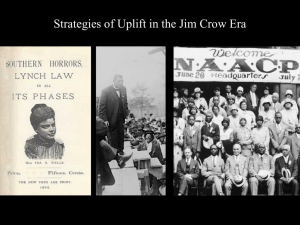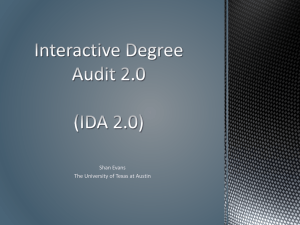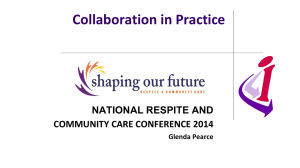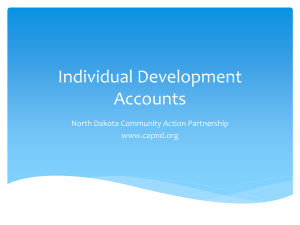Module 4
advertisement
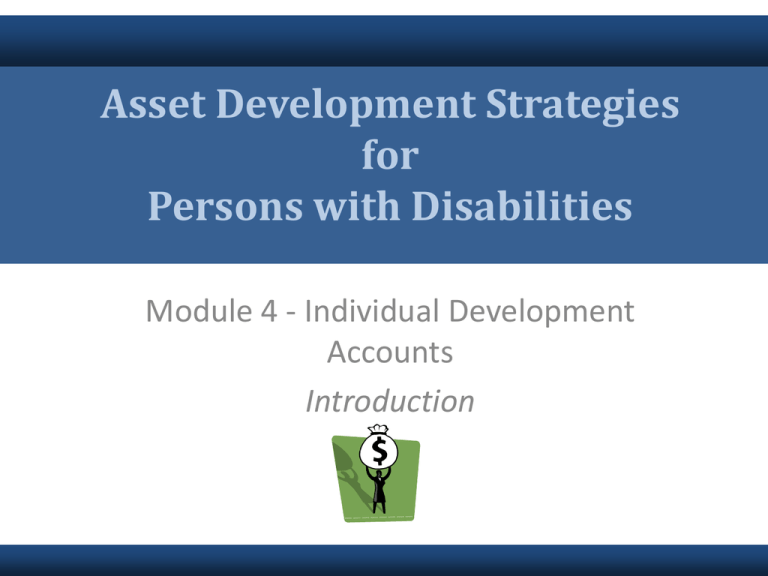
Asset Development Strategies for Persons with Disabilities Module 4 - Individual Development Accounts Introduction Module 4 • Today we will focus on a new asset building strategy to help you save and advance your economic selfsufficiency. This fourth session will provide you information about Individual Development Accounts (IDAs). • Before we learn about IDAs, let’s do an exercise. Module 4 • If you had a choice of saving dollars for: o o o buying a home, starting a business, or continuing education, Which one would it be? Tell us why you made your choice. Individual Development Accounts • These three goals are the goals for an Individual Development Account (IDA). Each will help you obtain an asset. A home can grow in value and someday be sold for a profit. • A business also can grow in value and someday be sold for profit. A business also can grow in value and increase your income that can provide you new funds to be saved and invested. • Continuing your education is also a proven strategy to gain skills that can help you get a better job and make more income. All three asset goals are important steps to advancing a better economic future. • Asset Development Strategies for Persons with Disabilities Module 4 - Individual Development Accounts Overview, Purpose, and Expected Outcomes Individual Development Accounts (IDAs) • Saving money from month to month is hard to do. • It would be easier to do if I told you that there is a program that will match dollar for dollar each dollar you set aside in a separate account for one of three asset goals: buying a home, starting a business, and continuing an education. • The program is called an Individual Development Account or IDA. Individual Development Accounts • Today, we are going to learn more about IDAs and the benefit to you in setting an asset goal and having a matched savings plan. We are going to hear from an IDA program provider and learn more about opportunities with IDA providers across the state. Individual Development Accounts • Participating in an IDA program is one way you can become more independent, less dependent on government benefits, and have a better economic future. • There are 4 IDA programs in Virginia. • From the homework assignment, we want you to learn more about an IDA program in your community. Individual Development Accounts • From our presentations and discussions today, we will learn: what is an IDA, o what are the key program elements, o who are IDA providers in Virginia, and o new choices to be made to benefit from saving and an asset building plan. o Asset Development Strategies for Persons with Disabilities Module 4 - Individual Development Accounts Main Presentation IDA: A Benefit for Low Income Workers • Individual Development Accounts or IDAs are matched savings accounts designed to help low income workers plan for and reach specific asset building goals. • Nationwide, there are over 13,000 individuals who are saving money each month as part of an IDA program. Federal Legislation Approved • Dream Demonstration influenced passage of the Assets For Independence Act (AFIA). • Provides 20 plus million dollars annually to fund IDA demonstration projects nationwide. Module 4 • Proved low-income workers could save and build assets. • Improved the self-concept and physical and mental health of low-income workers. Congressional Findings • Economic well-being does not solely come from income, spending, and consumption. It also requires savings, investment and accumulation of assets. • Assets can improve economic stability and independence, connect individuals with a viable and hopeful future and stimulate development of human and other capital. Savings Agreement • An eligible individual who is working signs a savings agreement with an IDA provider to establish an asset goal and how much income will be put in a special savings account for a specific purpose. Savings Agreement • The Savings Agreement: Identifies the Asset Objective o Sets a goal of the total amount to be saved and matched o Sets a savings/investment schedule of the specific amount to be deposited at regular intervals o Agreement reached with the Program Manager on a match rate o Individual Development Accounts • Federally supported IDA programs offer lowincome workers three choices for asset goals: Buy a Home o Start a Business o Continue higher education o Individual Development Accounts • The IDA established for an individual has two other core program elements in addition to setting an asset goal and a plan for saving to meet the goal: There is a match the IDA program provider will offer for each dollar saved in the account. 2. Each participant will also be required to participate in financial education classes. 1. Matched Savings • In IDA programs nationwide, the match may range from one to four dollars. • The maximum federal contribution to an IDA account is $2,000 and must be deposited with an equal amount of nonfederal dollars for a minimum of $4,000. Case Example • Susan has set an asset goal to start a business. Susan enters into a savings agreement with the IDA provider to save $50 per month for two years. • The IDA provider indicates that the program will match her contribution with four dollars for every dollar she saves and places in the account. Case Example • At the end of two years, Susan has contributed $1,200 to her IDA. The IDA program will match her savings with $4,800. • Susan now have $6,000 to start her business. Individual Development Accounts • All IDA savings plans must be accomplished within five years. • Many IDA participants leverage other public and private funding sources to meet their ultimate asset goal. Individual Development Accounts • For example, if the asset goal was to purchase a home and the savings plan was $50 per month for five years and was matched four to one, the individuals would have $15,000. • This IDA was further enhanced by a state’s first time homebuyer assistance program to make it possible to purchase a home. Financial Education • In IDA programs, there are federal requirements that participants enroll in financial education classes. • Most projects require at least 12.5 hours of training before a proposed asset can be purchased. IDA Program Eligibility • Eligibility is based on a maximum household level of income and often relies on the federal poverty level as a guideline. o o o Typical eligibility is 100 to 200 percent of the federal poverty level. Household net worth must be less that $10,000, excluding value of car or home. Individuals with disabilities who are working part- or fulltime and are eligible for EITC would also be eligible for an IDA. Minimum age requirements will vary by IDA program provider. IDA Federal Statistics (past six years) • 76% of participants were female • 85% had a high-school diploma • Age range of 20 through 49 years • About 20% were employed part-time • 33% had not used a checking account • 50% had no prior savings account Impact on Other Public Benefits • Federally funded IDAs are exempt from counting as an asset for the purposes of remaining eligible for SSI and Medicaid. • An IDA with savings plans could actually help preserve eligibility for Social Security benefits. Individual Development Account Providers • Statewide, there are 4 IDA programs. • IDA program managers could include: Community Action Agencies o State and Local Government Agencies o United Way Affiliates o Community and Faith-Based Groups o Find IDA Providers in Virginia • See attached list of IDA providers in Virginia Questions to ask IDA Providers 1. Who is eligible? 2. Focus on only home ownership or also starting a business or continuing higher education. 3. Are funds available to enroll new eligible low income workers? 4. What rate do they match savings? 5. What are the financial education requirements? IDA Example • “Samuel” Program Example o Beyond Acquiring Work to Fulfilling Dreams Are you ready for an IDA? • Are you ready to select one of three asset goals? • Are you working and want to commit to a savings plan and schedule? • Are you willing to attend financial education classes? • Are you a good credit risk that will encourage the IDA provider to enroll you in the program? Tips to Remember • You must be working and be willing to contribute to earned income • Your eligibility for SSI or Medicaid will not be impacted negatively. • You must make a commitment to saving weekly and/or monthly.
